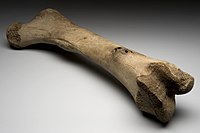
Photo from wikipedia
The microstructure of porous scaffolds plays a vital role in bone regeneration, but its optimal shape is still unclear. In this study, four kinds of porous titanium alloy scaffolds with… Click to show full abstract
The microstructure of porous scaffolds plays a vital role in bone regeneration, but its optimal shape is still unclear. In this study, four kinds of porous titanium alloy scaffolds with similar porosities (65%) and pore sizes (650 μm) and different structures were prepared by selective laser melting. Four scaffolds were implanted into the distal femur of rabbits to evaluate bone tissue growth in vivo. Micro-CT and hard tissue section analyses were performed 6 and 12 weeks after the operation to reveal the bone growth of the porous scaffold. The results show that diamond lattice unit (DIA) bone growth is the best of the four topological scaffolds. Through computational fluid dynamics (CFD) analysis, the permeability, velocity and flow trajectory inside the scaffold structure were calculated. The internal fluid velocity difference of the DIA structure is the smallest, and the trajectory of fluid flow inside the scaffold is the longest, which is beneficial for blood vessel growth, nutrient transport and bone formation. In this study, the mechanism of bone growth in different structures was revealed by in vivo experiments combined with CFD, providing a new theoretical basis for the design of bone scaffolds in the future.
Journal Title: Journal of Biological Engineering
Year Published: 2021
Link to full text (if available)
Share on Social Media: Sign Up to like & get
recommendations!